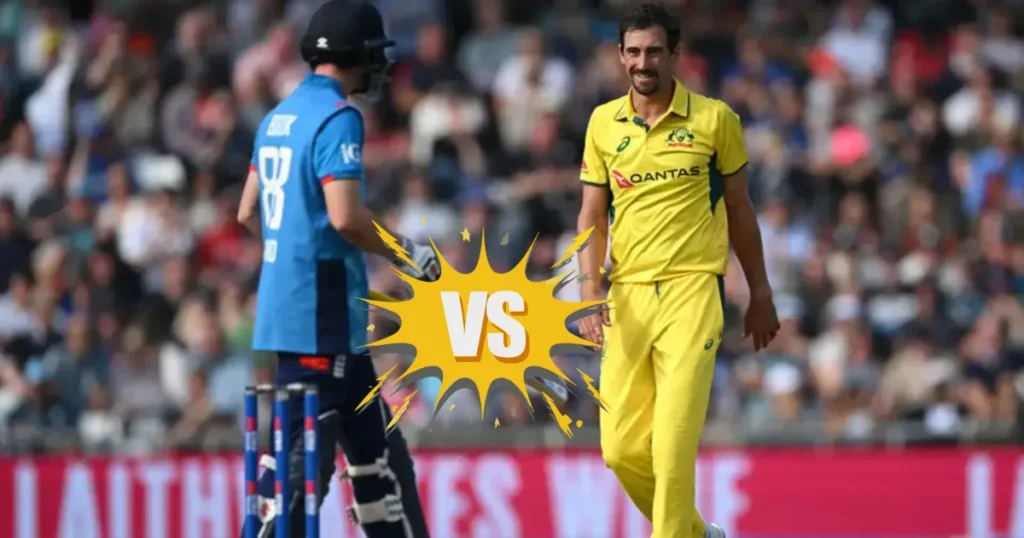The cricket rivalry between England Cricket Team vs Australian Men’s Cricket Team Timeline is like a classic movie you never get tired of watching. It’s packed with drama, passion, and moments that make you jump out of your seat. Known as the Ashes, this contest is the oldest and most iconic in cricket history, dating back to 1877. Whether you’re a die-hard cricket fan or just someone curious about the sport, this blog post will take you on a journey through the key moments, epic battles, and unforgettable players that have shaped this rivalry. Plus, I’ve included a detailed table at the end to make it super easy to follow the timeline. Let’s dive in!
England Cricket Team vs Australian Men’s Cricket Team Timeline
Here’s a clear, easy-to-read table summarizing the key moments in the England Cricket Team vs Australian Men’s Cricket Team Timeline. It’s perfect for quick reference and covers the major milestones.
|
Year |
Event/Series |
Key Moment |
Winner |
Notable Players |
|---|---|---|---|---|
| 1877 |
First Test Match |
Australia wins by 45 runs at MCG, first Test century by Charles Bannerman. |
Australia |
Charles Bannerman (Aus) |
| 1882 |
The Oval Test |
Australia wins by 7 runs; Ashes term coined after mock obituary. |
Australia |
Fred Spofforth (Aus) |
| 1882–83 |
Ashes Series Begins |
England presented with Ashes urn in Australia. |
England |
Ivo Bligh (Eng) |
|
1900s |
Early Ashes Series |
England dominates early; Australia rises with Victor Trumper. |
Mixed |
W.G. Grace (Eng), Victor Trumper (Aus) |
| 1930 |
Bradman’s Breakthrough |
Don Bradman scores 974 runs in series, including 334 at Leeds. |
Australia |
Don Bradman (Aus) |
| 1932–33 |
Bodyline Series |
England uses controversial Bodyline tactic to counter Bradman. |
England |
Douglas Jardine (Eng), Harold Larwood (Eng) |
| 1948 |
The Invincibles |
Australia goes unbeaten in England, wins 4–0. |
Australia |
Don Bradman (Aus), Ray Lindwall (Aus) |
| 1956 |
Laker’s Record |
Jim Laker takes 19 wickets in Manchester Test. |
England |
Jim Laker (Eng) |
| 1970–71 |
England’s Triumph |
England wins 2–0 in Australia under Ray Illingworth. |
England |
Ray Illingworth (Eng), John Snow (Eng) |
| 1977 |
Jubilee Series |
Series drawn 2–2; Ian Botham emerges as a star. |
Drawn |
Ian Botham (Eng), Dennis Lillee (Aus) |
| 1981 |
Botham’s Ashes |
Ian Botham’s 149* at Headingley leads miracle win; England wins 3–1. |
England |
Ian Botham (Eng), Bob Willis (Eng) |
| 1989–2003 |
Australian Dominance |
Australia wins 8 straight Ashes series; Shane Warne’s “Ball of the Century” in 1993. |
Australia |
Shane Warne (Aus), Glenn McGrath (Aus) |
| 2005 |
Greatest Ashes Ever |
England wins 2–1 in thrilling series; Edgbaston Test won by 2 runs. |
England |
Andrew Flintoff (Eng), Michael Vaughan (Eng) |
| 2010–11 |
England in Australia |
England wins 3–1, first Ashes win in Australia in 24 years. |
England |
Alastair Cook (Eng), James Anderson (Eng) |
| 2013–14 |
Australian Whitewash |
Australia wins 5–0 with Mitchell Johnson’s pace. |
Australia |
Mitchell Johnson (Aus) |
| 2019 |
Stokes’ Miracle |
Ben Stokes’ 135* at Headingley; series drawn 2–2, Australia retains Ashes. |
Drawn |
Ben Stokes (Eng), Steve Smith (Aus) |
| 2023 |
Bazball Ashes |
England draws 2–2 under Stokes’ attacking style; Australia retains Ashes. |
Drawn |
Ben Stokes (Eng), Pat Cummins (Aus) |
The Birth of a Rivalry: 1877 and the First Test Match
Picture this: it’s March 15, 1877, at the Melbourne Cricket Ground (MCG). Cricket is already a big deal in England, but now it’s spreading to Australia. The two nations face off in what’s later recognized as the first-ever Test match. Australia wins by 45 runs, and Charles Bannerman, an Aussie batter, scores the first Test century with 165 runs. This match wasn’t just a game—it was the spark that ignited a rivalry that would last for centuries.
Back then, cricket was a gentleman’s game, played in white flannels with no helmets or fancy tech. Travel between England and Australia took months by sea, so tours were rare and special. Despite the distance, the competitive spirit was fierce, setting the stage for what would become the Ashes.
The Ashes Are Born: 1882
Fast forward to 1882, and we get to one of the most famous moments in cricket history. Australia tours England and pulls off a shocking victory at The Oval in London, beating England by seven runs. The English crowd is stunned—how could they lose at home? A newspaper called The Sporting Times publishes a cheeky obituary saying English cricket has “died” and “the body will be cremated and the ashes taken to Australia.”
This playful jab gives birth to the Ashes, the name for the Test series between England and Australia. Later that year, England’s captain Ivo Bligh tours Australia and is given a tiny urn, said to contain the ashes of a burnt cricket bail. That urn, now known as the Ashes urn, becomes the symbol of this epic rivalry. It’s only about four inches tall, but it carries the weight of cricketing pride for both nations.
Early Years: 1880s to 1900s
In the late 19th century, the Ashes series becomes a regular event, with England and Australia trading blows. England dominates early on, thanks to players like W.G. Grace, a bearded legend who was basically the rock star of Victorian cricket. He scored 152 in England’s first home Test win against Australia in 1880.
Australia, though, has its own heroes. Players like Fred “The Demon” Spofforth, a fiery bowler, and Billy Murdoch keep the Aussies competitive. Spofforth’s 7/44 in the 1882 Oval Test saves Australia from defeat, cementing his place in Ashes lore. By the turn of the century, Australia starts to flex its muscles, with stars like Victor Trumper, a stylish batter who’s still considered one of the greatest ever.
The Bradman Era: 1920s to 1930s
If there’s one name that defines the Ashes, it’s Sir Donald Bradman. This Australian batter, nicknamed “The Don,” takes cricket to another level in the 1920s and 30s. His batting average of 99.94 is so ridiculous it’s still unmatched. In the 1930 Ashes in England, Bradman scores 974 runs in the series, including a triple century (334) at Leeds. England has no answer for him, and Australia dominates.
But the 1932–33 series, known as “Bodyline,” is a turning point. England, desperate to stop Bradman, uses a controversial tactic: bowling fast, short-pitched balls aimed at the batter’s body. Led by captain Douglas Jardine and bowler Harold Larwood, England wins the series, but the tactic causes a diplomatic row. Australia calls it unsporting, and the two nations nearly fall out over it. Bodyline is eventually banned, but it shows how intense this rivalry can get.
Post-War Battles: 1940s to 1960s
World War II pauses cricket, but the Ashes resumes in 1946–47 with Australia still on top. Bradman, now older but still deadly, leads Australia to victory. The 1948 Australian team, nicknamed “The Invincibles,” goes unbeaten on their England tour, winning the Ashes 4–0. Players like Ray Lindwall and Keith Miller make life tough for England.
The 1950s and 60s bring more balance. England fights back with players like Len Hutton, who becomes the first professional captain, and Jim Laker, a spinner who takes an incredible 19 wickets in a single Test in 1956 at Manchester. That’s still a record! Australia, powered by Richie Benaud and Neil Harvey, keeps the rivalry tight. Every series feels like a heavyweight boxing match, with both teams landing big punches.
The Pace Wars: 1970s
The 1970s are all about fast bowling. Australia unleashes Dennis Lillee and Jeff Thomson, two of the scariest bowlers ever. Their raw pace terrifies England batters, and Australia dominates early in the decade. England, though, has its own stars. Ian Botham, an all-rounder with swagger, emerges as a game-changer. In 1977, Botham’s heroics help England draw the Ashes in a series celebrating the Queen’s Silver Jubilee.
The 1970–71 series in Australia is another classic. England, led by Ray Illingworth, wins 2–0, reclaiming the Ashes after years of Australian dominance. The rivalry is now about more than cricket—it’s a clash of cultures, with England’s grit facing Australia’s aggression.
Botham’s Ashes: 1981
If you’ve heard of the Ashes, you’ve probably heard of 1981. England’s Ian Botham turns the series into his personal stage. After resigning as captain mid-series, Botham goes on a rampage. At Headingley, England is down and out, following on 227 runs behind. Botham smashes 149 not out, and Bob Willis takes 8 wickets to pull off a miracle win by 18 runs. It’s one of the greatest comebacks in cricket history.
Botham isn’t done. At Edgbaston, he takes 5 wickets for just 1 run in a spell that destroys Australia. England wins the series 3–1, and “Botham’s Ashes” becomes legend. For England fans, it’s the stuff of dreams; for Aussies, it’s a nightmare they still talk about.
Australian Dominance: 1989–2003
From 1989, Australia takes over. Led by captains like Allan Border, Mark Taylor, and Steve Waugh, they build a team of superstars: Shane Warne, Glenn McGrath, Ricky Ponting, and the Waugh brothers. Warne, a leg-spinner with a magician’s touch, bamboozles England batters. His “Ball of the Century” in 1993, which spins a mile to dismiss Mike Gatting, is still replayed on highlight reels.
England struggles during this period, with a revolving door of captains and inconsistent teams. Australia wins eight straight Ashes series from 1989 to 2002–03, including brutal 4–1 thrashings in 2001 and 2002–03. For English fans, it’s a tough time, but the rivalry keeps burning.
The Epic of 2005
The 2005 Ashes is the series that brings England back. Under captain Michael Vaughan and with players like Andrew Flintoff, Kevin Pietersen, and Simon Jones, England plays fearless cricket. The series is a nail-biter, with every Test packed with drama. At Edgbaston, England wins by just 2 runs in one of the closest Tests ever. At Trent Bridge, Flintoff’s all-round brilliance seals another thriller.
The final Test at The Oval sees England draw the match to win the Ashes 2–1, ending 16 years of Australian dominance. England erupts in celebration, with open-top bus parades and fans chanting Flintoff’s name. For Australia, it’s a rare defeat, but they respect England’s fight. This series is often called the greatest Ashes ever.
Modern Era: 2010s to 2020s
The 2010s and 2020s keep the rivalry red-hot. England enjoys a golden patch under Andrew Strauss, winning the Ashes in Australia in 2010–11, their first Down Under in 24 years. Alastair Cook’s marathon batting and James Anderson’s swing bowling lead the way.
Australia bounces back in 2013–14 with a 5–0 whitewash in Australia, powered by Mitchell Johnson’s fiery pace. The 2019 series is a classic, with Ben Stokes pulling off another Headingley miracle, scoring an unbeaten 135 to chase 359. The series ends 2–2, but Australia retains the Ashes.
In the 2020s, England’s “Bazball” style under Ben Stokes and coach Brendon McCullum brings a new vibe. It’s all about attacking cricket, and the 2023 Ashes is a thriller. England fights back from 2–0 down to draw 2–2, with Stokes and Stuart Broad leading the charge. Australia, with Pat Cummins and Steve Smith, holds firm to keep the Ashes.
Why the Ashes Matters
The Ashes isn’t just about cricket—it’s about pride, history, and two nations giving it their all. For fans, it’s like a family feud where every match feels personal. The players, from Bradman to Botham to Stokes, become legends because of this series. Even today, with T20 and ODI cricket taking over, the Ashes remains the ultimate test of skill and heart.
Whether it’s a nail-biting finish at Edgbaston or a Bradman masterclass at Lord’s, the Ashes delivers moments that stick with you forever. It’s a rivalry that’s as fierce in 2025 as it was in 1877, and it’s not slowing down anytime soon.
Looking Ahead
As we head into 2025, the Ashes is gearing up for another chapter. Australia will host England in the 2025–26 series, starting November 8, 2025, at The Gabba. With England’s bold Bazball approach and Australia’s world-class players like Pat Cummins and Steve Smith, it’s sure to be another epic. Whether you’re cheering for England or Australia, one thing’s certain: the Ashes will keep delivering unforgettable moments.






